Irrigation Modernization
Irrigation is the Backbone of Agriculture in the Western United States
In the western part of the United States, a century-old network of about 150,000 miles of open canals transports irrigation water from rivers and reservoirs to agricultural producers. This water delivery infrastructure is a backbone of U.S. agriculture, serving nearly 40 million acres of land across 17 Western states1 and supporting 50 percent of the Nation’s crop revenues.2
Irrigation Infrastructure Needs a Refresh
Earthen canals remain the most common way irrigation water is delivered in the West. They can vary from as small as a few feet across to well over 50-feet, carrying very large volumes of water. Many canals have reached the end of their useful life, requiring significant and costly annual maintenance to remain in service and losing 15–30 percent or more of their water to seepage or evaporation,3,4 exacerbating drought challenges for both farmers and rivers.
Modernizing irrigation water infrastructure, such as water conveyance systems and on-farm water delivery to crops, can achieve a wide variety of benefits, including water conservation, energy savings and/or generation, environmental restoration, and rural and agricultural resilience.
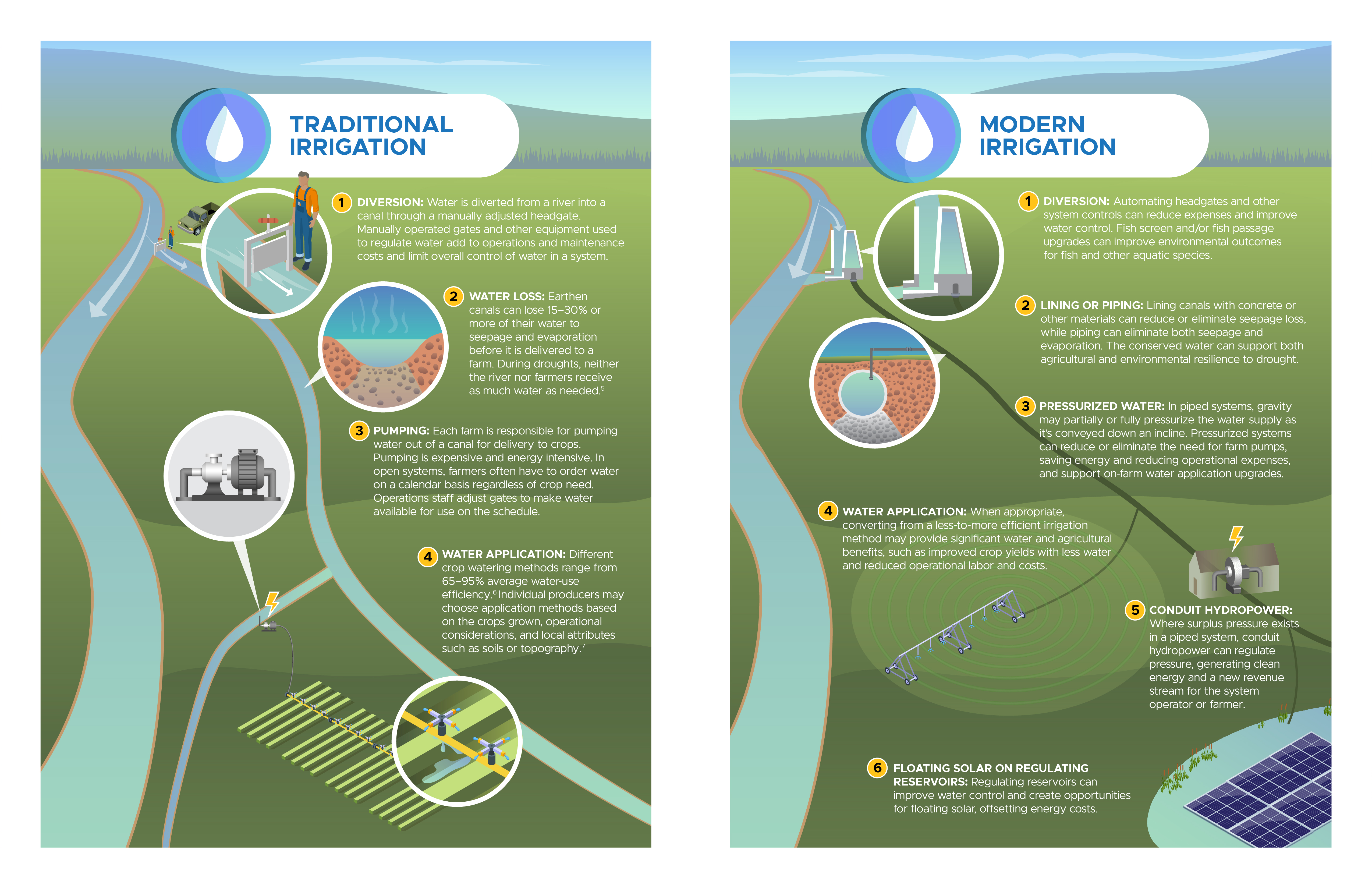
Potential Agricultural and Environmental Benefits
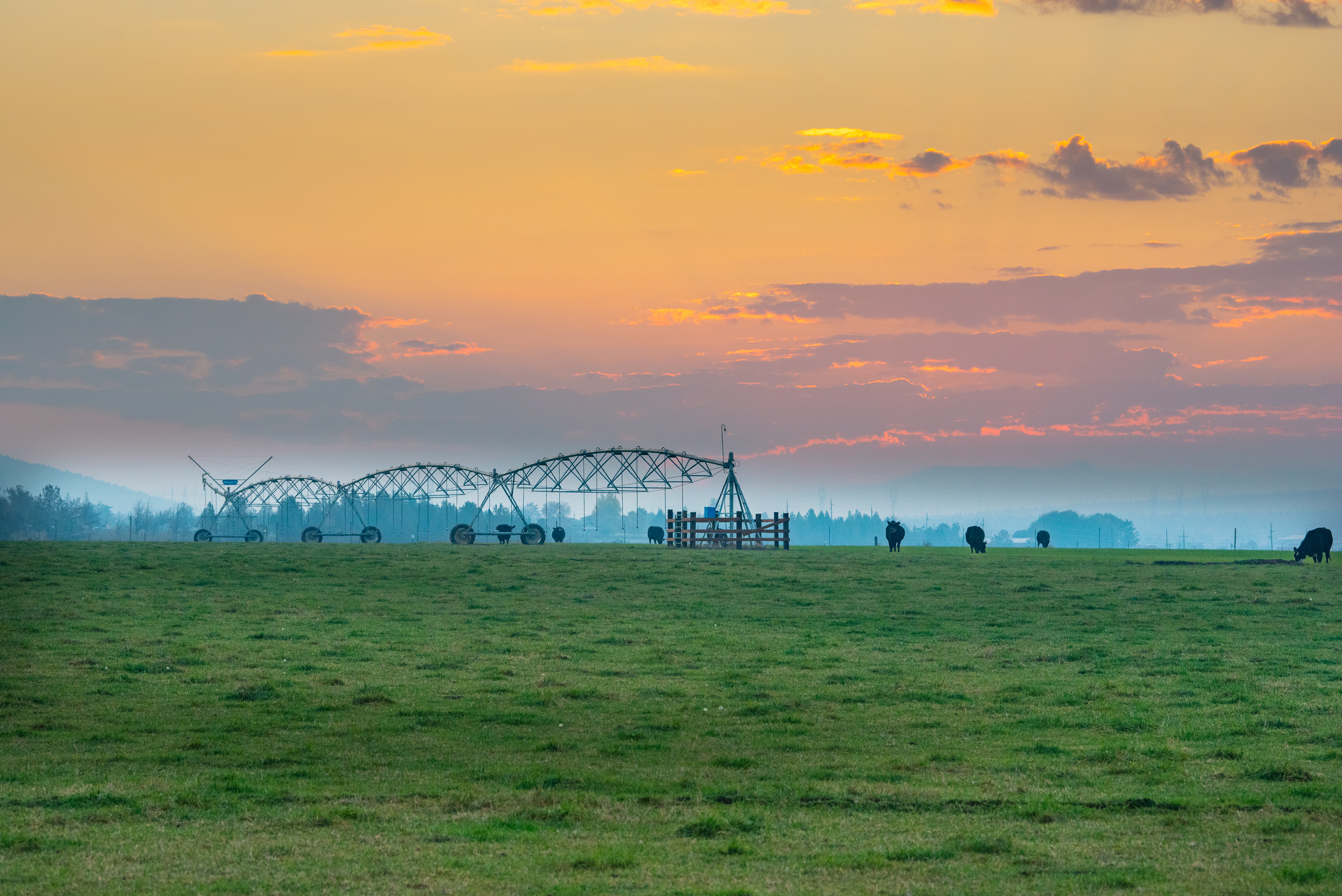
- Improved agricultural production by stretching water supplies through conservation.
- Reduced operation and maintenance costs.
- Improvements in fish passage and fish screening.
- Increased in-stream water availability for fish and wildlife.
- Water quality improvements.
- Economic resilience in rural communities.
- Targeted groundwater recharge.
Potential Energy Opportunities
- Reduced on-farm pump energy use.
- Energy generation through conduit hydropower installations or floating solar photovoltaics on reservoirs.
- Local or regional energy resilience by incorporating battery storage with renewable energy installations.
- Revenues from locally owned energy facilities can support further reinvestment into modernization projects.
Barriers and Challenges to Overcome
Irrigation modernization efforts face challenges related to cost and regulatory process timelines. The large scale of water conveyance infrastructure modernization makes both lining and piping complex and expensive, sometimes costing over $1 million per mile of installed pipe. Federal funding has significantly increased the scale of the projects able to move forward in the last decade, but many agencies may be involved, and project reviews can take years, delaying benefits. Project planning funds are limited relative to the needs and potential benefits available and are not equally available across states. Addressing these barriers is both possible and critical to enable the benefits that come through implementation to be accelerated and scaled across the West.
Examples of Irrigation Modernization in Action
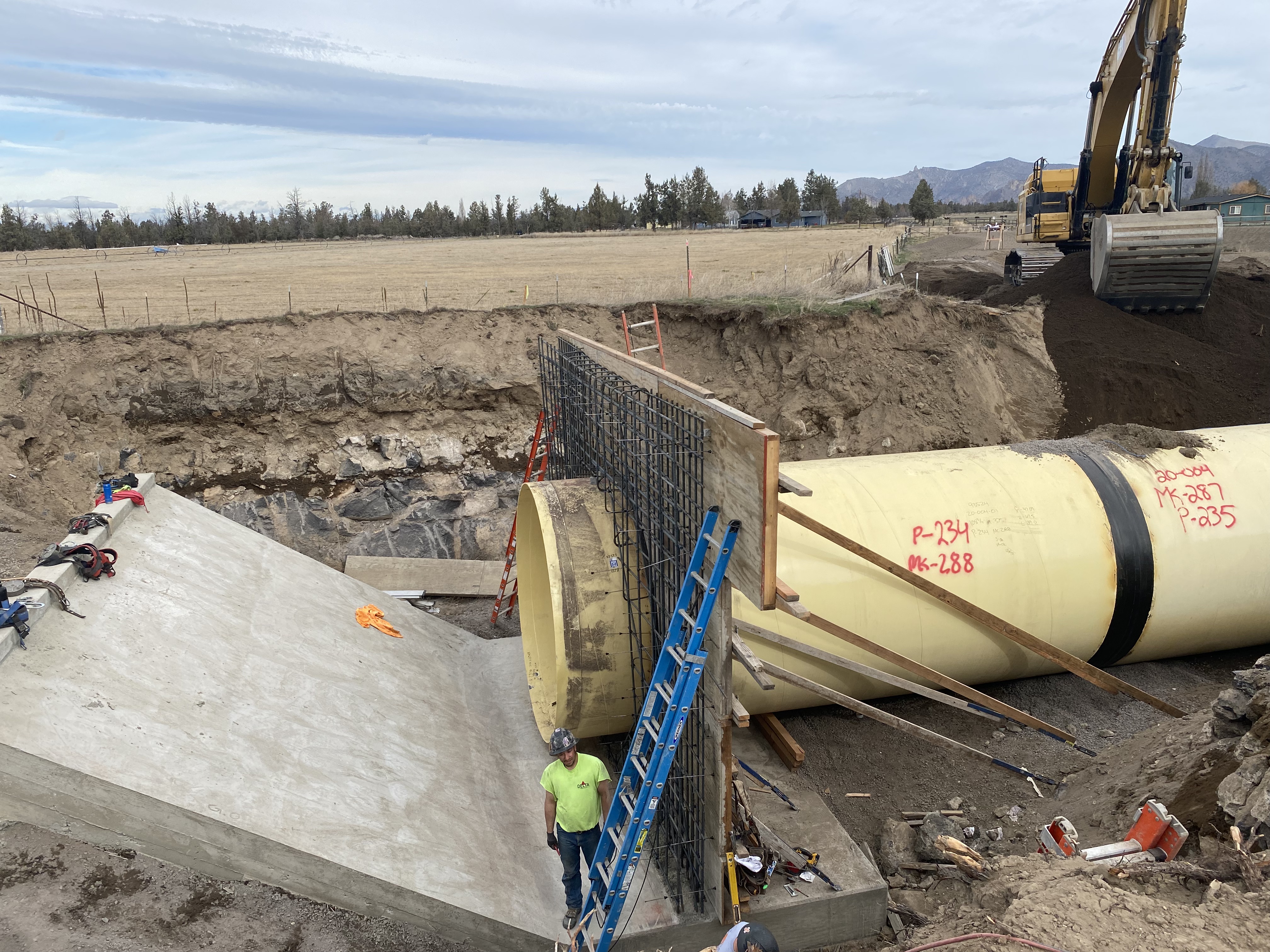
Central Oregon Irrigation District
The Central Oregon Irrigation District (COID) serves over 46,000 acres of irrigated agriculture outside of Bend, Oregon. COID operates a system of over 400 miles of canals dug through porous, volcanic basalt using horses and shovels in the early 1900’s. The district’s large canals lose up to 50 percent of their water to seepage, creating challenges for farmers and ranchers in the area and for endangered species in the Deschutes River, COID’s water source.
COID began piping its canals to conserve water and take advantage of local topography to generate hydropower: the district operates a 6 megawatt (MW) run-of-river hydropower facility and a 3.5 MW conduit hydropower plant made possible by piping. Comprehensive modernization planning by COID shows the potential to conserve 156 cubic feet per second of water through continued piping—enough to fill an Olympic swimming pool every 10 minutes during the irrigation season. The piping also creates the opportunity to install another 6–10 MW of conduit hydropower across three future sites with the potential to save over 10,000 MWh annually due to reduced pump usage, and support on-farm irrigation upgrades that can conserve additional water while boosting agricultural production.
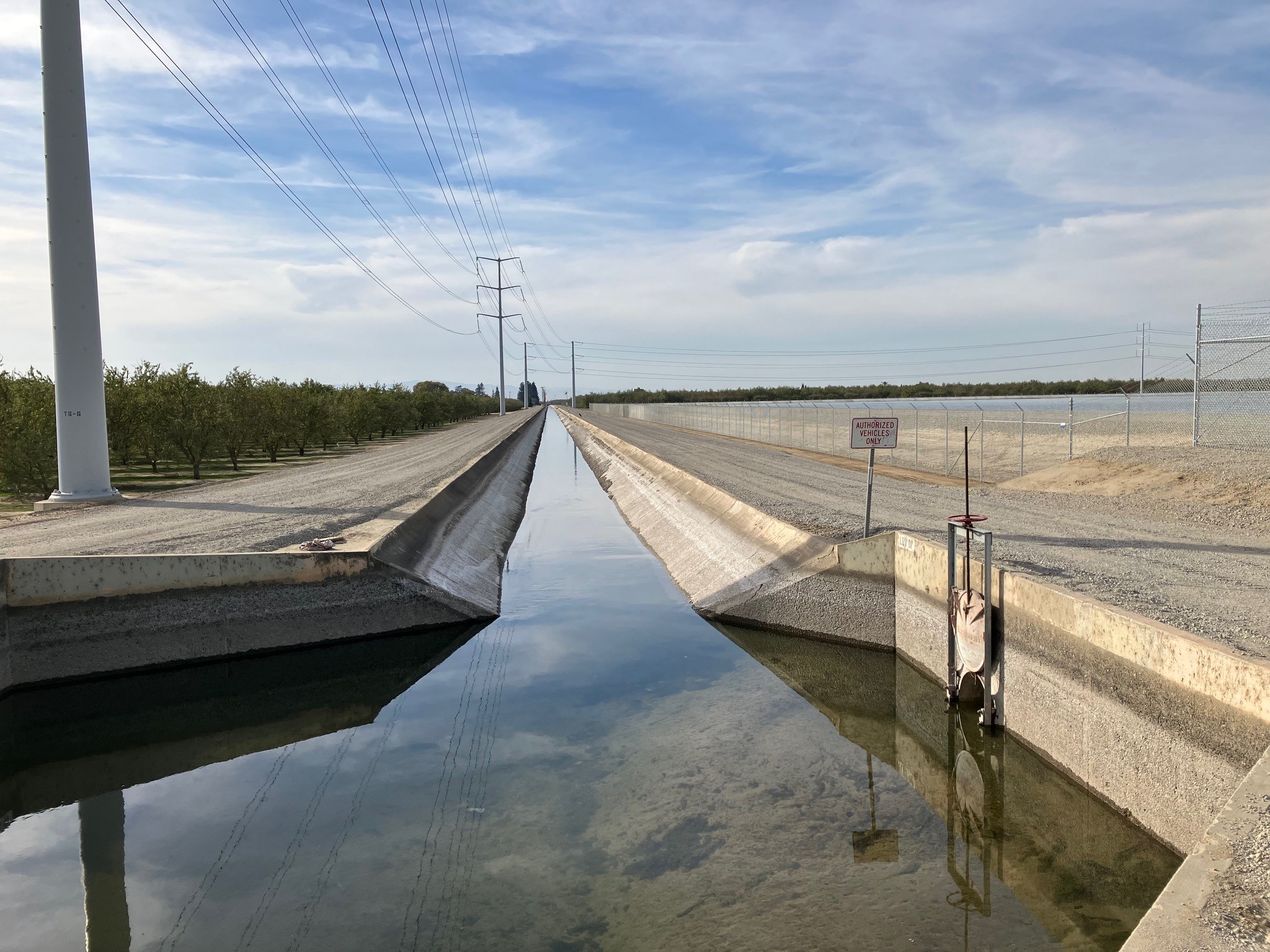
Turlock Irrigation District
The Turlock Irrigation District (TID) serves 150,000 acres of irrigated agriculture in California’s Central Valley. Founded in 1887, TID diverts water from the Tuolumne River through a system of over 250 miles of canals and laterals.
TID has spent decades modernizing its system to conserve water, improve reliability, improve customer service, and generate energy. Over 92 percent of TID’s canals are lined, dramatically reducing water lost to seepage. Monitoring of water levels and automation of gates throughout the system enables the district to further conserve water while reducing operational costs. The installation of regulation reservoirs increases operational flexibility, reduces end spills, and creates the opportunity to install floating solar, which may reduce evaporative losses and the growth of local aquatic plants. TID also operates both large-scale conventional hydropower and smaller conduit hydropower facilities in its water system.
Working with researchers from Scripps Institution of Oceanography, TID pioneered a modeling system that gives the district highly accurate knowledge of watershed conditions, enabling better planning for water storage during droughts and reservoir releases to avoid flooding in advance of heavy rains.
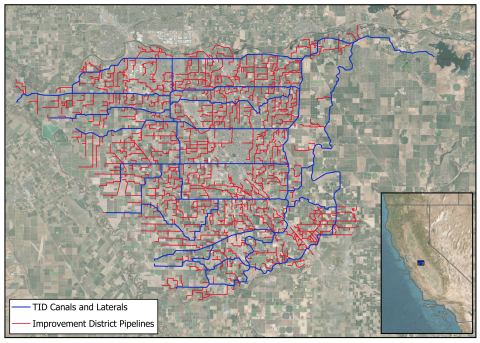
Programmatic work supporting Irrigation Modernization is a joint effort of the Idaho National Laboratory and Pacific Northwest National Laboratory, with funding provided by the U.S. Department of Energy’s Water Power Technologies Office.
References
1 United States Department of Agriculture. (2017). Summarized Data for All Irrigated Farms, Set 1: Aggregate Irrigation Farm Values for All Irrigated Farms. United States Department of Agriculture, Economic Research Service.
2 Stubbs, M. (2016). Irrigation in U.S. Agriculture: On-Farm Technologies and Best Management Practices. Congressional Research Service.
3 Lancaster, D. (1952). Measurement of Seepage Losses from Irrigation Canals. U.S. Bureau of Reclamation.
4 Hrozencik, R. et. al. (2022). A National Estimate of Irrigation Canal Lining and Piping Water Conservation. National Bureau of Economic Research.
5 Howell, T. 2003. Irrigation Efficiency. Encyclopedia of Water Science.
6 Brown, P. 2008. Flood vs. Pivot Irrigation for Forage Crops: What Are The Advantages and Disadvantages? Proceedings of the 2008 California alfalfa and forage symposium and western seed conference. UC Cooperative Extension.
